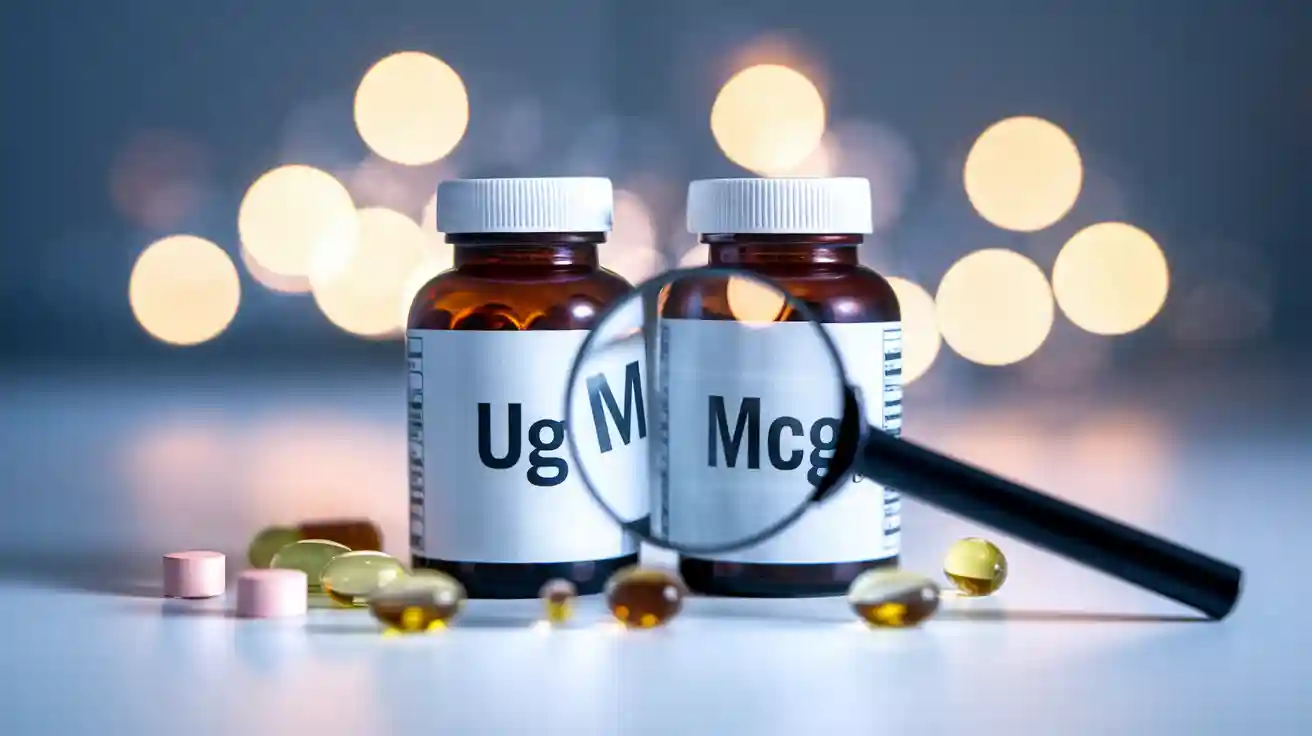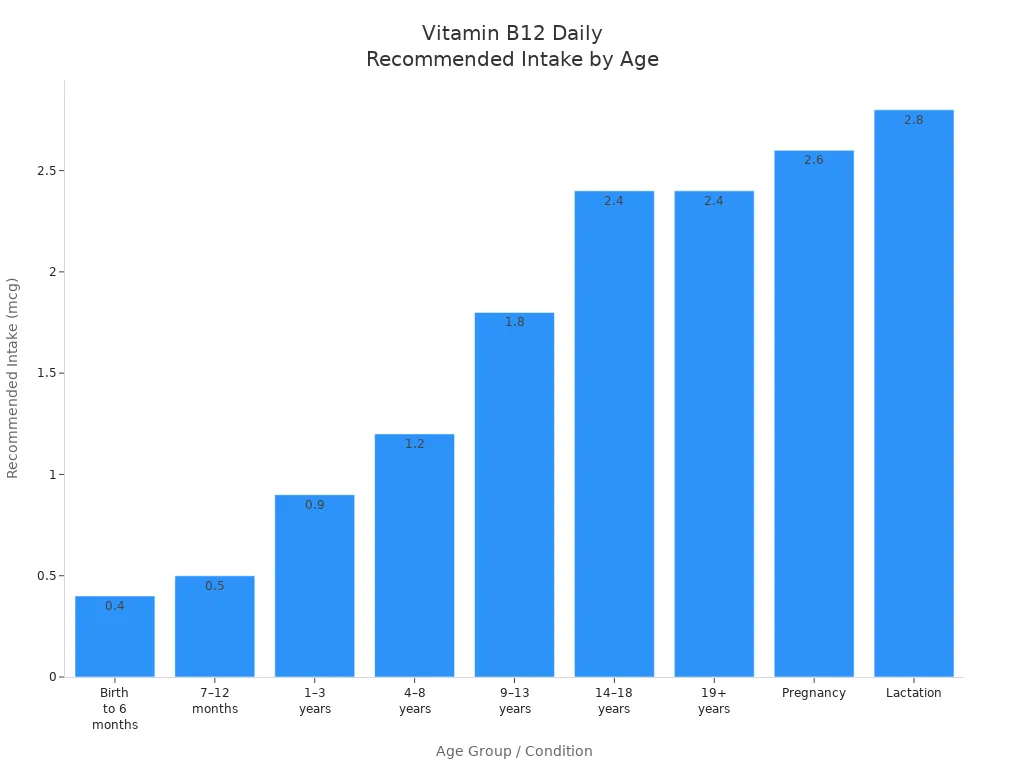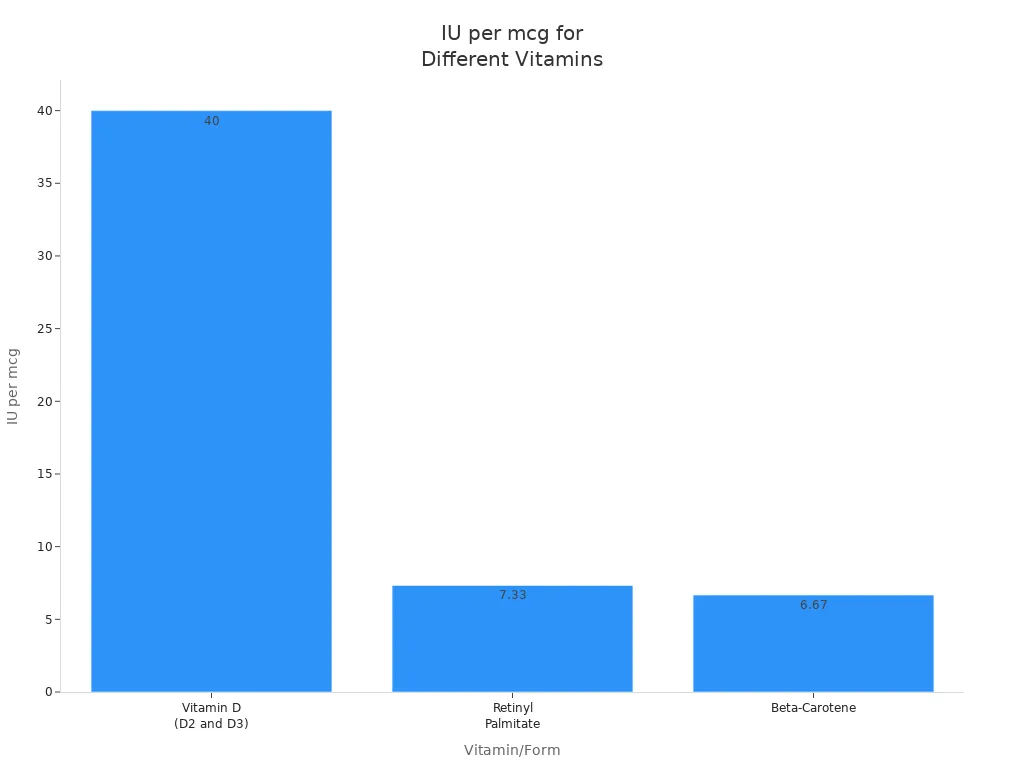Difference between ug and mcg on Vitamin Labels
Table of Contents

You might notice the difference between ug and mcg on vitamin labels, but they actually represent the same measurement—a microgram, or one millionth of a gram. In the US, using mcg is considered safer and clearer. For example, vitamin D and B12 recommendations typically use mcg.


Microgram and mcg Meaning
What Is a Microgram?
You often see the word microgram on vitamin labels. A microgram is a very small unit of mass. Scientists define a microgram as one millionth of a gram. In numbers, this means 1 microgram equals 0.000001 grams. The metric system uses the prefix “micro-” to show a factor of one millionth, written as 10^-6. You can think of it as dividing one gram into a million tiny pieces. This small measurement helps you understand how much of a nutrient you get from vitamins or supplements.
Tip: When you see microgram, remember it is much smaller than a milligram or a gram. This helps you avoid confusing different vitamin measurements.
Why Use mcg Instead of μg or ug?
You might wonder why some labels use mcg, while others use ug or even the Greek letter μg. In the United States, the Food and Drug Administration (FDA) prefers mcg on labels. This choice makes things clearer for you. The Greek letter μ can look confusing or may not print well on all packaging. Using mcg helps everyone read and understand the label easily. The FDA also wants labels to look the same everywhere, so you do not get mixed up. Using mcg instead of ug or μg helps prevent mistakes, especially when you need to know the exact amount of a vitamin or mineral.
- The FDA prefers mcg for clarity and safety.
- The Greek letter μ is not always easy to recognize.
- Using mcg helps avoid confusion and keeps labels consistent.
Where You See Microgram on Labels
You will find microgram listed on many nutrition and supplement labels. This unit is common for nutrients that your body needs in tiny amounts. Vitamins and minerals like vitamin D, vitamin B12, folate, selenium, and iodine often use microgram as their measurement. When you look at the Supplement Facts or Nutrition Facts panel, you will see mcg next to these nutrients. This helps you know exactly how much you are getting in each serving.
| Nutrient | Unit | Example Daily Values (mcg) |
|---|---|---|
| Selenium | micrograms | 20 – 70 |
| Chromium | micrograms | 5.5 – 45 |
| Molybdenum | micrograms | 3 – 50 |
| Folate/Folic Acid | micrograms | 400 |
| Vitamin B12 | micrograms | 2.4 |
| Vitamin D | micrograms | 20 |
| Vitamin A | micrograms | 900 |
| Iodine | micrograms | 150 |
| Vitamin K | micrograms | 120 |

You can see that microgram is the standard unit for many important nutrients. This makes it easier for you to compare products and make healthy choices. Always check the label for mcg, ug, or microgram to know the right amount for your needs.
Difference Between mcg, ug, and μg

Why the Different Symbols?
You may notice a difference in how vitamin labels show the microgram measurement. Some labels use mcg, others use ug, and some use μg. Each symbol means the same thing—a microgram—but the reason for these differences comes from history and technology.
| Reason Category | Explanation |
|---|---|
| Technical Encoding Issues | The official SI prefix for micro uses the Greek letter mu (μ), which is not part of the Latin alphabet, causing encoding challenges in character sets. |
| Unicode Character Codes | Unicode includes two codes for mu: U+03BC (Greek small letter mu) and U+00B5 (micro sign) for legacy compatibility, leading to symbol variation. |
| Legacy Compatibility | The micro sign (U+00B5) was included to maintain compatibility with older character sets like ISO/IEC 8859-1 and DEC MCS, causing coexistence of symbols. |
| Substitution in Text | When Greek characters are unavailable, ‘u’ is used as a substitute, and ‘mc’ is also used (e.g., ‘mcg’ for microgram). |
| Medical Safety Concerns | In healthcare, ‘μg’ is sometimes deprecated to avoid misreading handwritten prescriptions, leading to alternatives like ‘mcg’ or writing ‘microgram’ fully. |
| Ambiguity and Obsolescence | The alternative ‘mcg’ could be ambiguous but the rarely used ‘micri-‘ prefix is obsolete, reinforcing the use of multiple symbols historically. |
You see mcg most often in the United States. This symbol helps you avoid confusion because the Greek letter μ can look like an m or u in handwriting. Sometimes, labels use ug when the Greek letter is not available. The difference in symbols comes from technical limits, old computer systems, and the need for safety in medical settings. You should always check the label to make sure you understand the measurement.
Note: The difference between mcg, ug, and μg is only in the symbol. The value stays the same—a microgram.
Safety and Labeling Standards
You need clear information on vitamin labels to avoid mistakes. Pharmaceutical companies work hard to make sure you see the right measurement. They use professional translators who know medical terms and local customs. This helps you read and understand dosage instructions, especially when you see mcg or microgram. Companies avoid using automated translation tools because these can make errors. Clear labeling helps you tell the difference between milligrams (mg) and micrograms (mcg), which is very important for your safety.
- Companies use expert translators for accuracy.
- Labels show clear units to prevent dangerous dosing errors.
- Regulatory agencies like the FDA and EMA require strict standards for drug labels.
- Certified translations are needed for official documents and patient leaflets.
- Translators adapt text for clarity, helping you and your healthcare provider avoid confusion.
The FDA gives guidance to manufacturers about how to show vitamin measurements on labels. These guidelines recommend using mcg for microgram, but they do not always make it a legal rule. The FDA updates these recommendations in official documents and the Federal Register. Manufacturers must follow any new regulations, especially those in Title 21, Part 101 of the Code of Federal Regulations.
The FDA also explains how to declare vitamins and minerals on nutrition and supplement facts labels. You see instructions for serving sizes, unit conversions, and label formats. The FDA sets deadlines for companies to update their labels. Large companies had to comply by January 1, 2020, and smaller companies had an extra year. These guidelines help you see the correct measurement and avoid mistakes.
Tip: Always look for mcg on labels. This symbol is clear and helps you avoid confusing microgram with milligram.
You can trust that companies and regulators work together to keep vitamin labels safe and easy to read. The difference in symbols comes from history, technology, and safety needs. When you see mcg, ug, or μg, remember they all mean microgram, but mcg is the safest and most common choice.
How Many mcg in mg? Conversion Guide

1 mcg Is How Many mg?
You may wonder how many mcg in mg or how to convert between these units. The answer is simple: 1 milligram (mg) equals 1,000 micrograms (mcg). If you want to know 1 mcg is how many mg, you divide by 1,000. So, 1 mcg equals 0.001 mg. This conversion helps you understand the small amounts found in vitamins and supplements. For example, if you see 500 mcg to mg, you divide 500 by 1,000, which gives you 0.5 mg.
Tip: Always check if the label says mg or mcg. Mixing them up can lead to taking too much or too little of a vitamin.
Microgram Conversion Table
A simple table can help you with conversions of mcg to mg and grams. Use this table when converting measurements on supplement labels:
| Unit | Equivalent |
|---|---|
| 1 gram (g) | 1,000 mg or 1,000,000 mcg |
| 1 milligram (mg) | 1,000 mcg |
| 1 microgram (mcg) | 0.001 mg or 0.000001 g |
| 500 mcg | 0.5 mg |
| 1,000 mcg | 1 mg |
Is 1000 mcg the same as 1 mg? Yes, they are equal. This table makes it easy to see the relationships and avoid mistakes.
Avoiding Dosage Mistakes
You need to pay close attention to units when reading supplement labels. Many people confuse mcg and mg, which can cause serious dosing errors. Here are some ways to stay safe:
- Double-check the units before taking any supplement.
- Use conversion tables to help with converting measurements.
- Ask your healthcare provider if you are unsure about a dose.
- Look for clear labels that use mcg instead of symbols like μg.
Remember, taking the wrong amount can be dangerous. Always use the correct unit and check your math when converting.
Other Units: IU vs. mcg
What Is IU?
You may see IU on vitamin labels and wonder what it means. IU stands for International Unit. This unit measures the biological activity or effect of a vitamin, hormone, or medication. IU does not show the weight of a substance. Instead, it tells you how strong or effective the vitamin is in your body. International experts agreed on this system to help you compare different forms of vitamins, even when they have different strengths. For example, vitamin E comes in several forms, and each form has a different potency. IU helps you understand how much effect you get, no matter which form you choose. This system is used worldwide for vitamins like A, D, E, and K. IU makes it easier for you and your healthcare provider to compare products and choose the right dose.
IU vs. Microgram
You might notice both IU and mcg on supplement labels. IU measures the biological effect, while mcg shows the actual weight of the vitamin. For fat-soluble vitamins such as A, D, and E, IU is common because these vitamins exist in different forms with different strengths. Micrograms help you know the exact amount present in a product. There is no simple conversion between IU and mcg because IU depends on the vitamin’s form and potency. For example, vitamin D converts at 40 IU per mcg, but vitamin A’s conversion rate changes depending on its chemical form.
| Vitamin/Form | IU per mcg | Example Conversion |
|---|---|---|
| Vitamin D (D2 and D3) | 40 IU/mcg | 125 mcg = 5,000 IU |
| Retinyl Palmitate (Vitamin A) | ~7.33 IU/mcg | 500 mcg = 3,665 IU (approximate) |
| Beta-Carotene (Vitamin A) | ~6.67 IU/mcg | 500 mcg = 3,333 IU (approximate) |
| Retinol (Vitamin A) | varies | 1,500 IU = 450 mcg |
| Retinyl Propionate (Vitamin A) | varies | 1,500 IU = 538.5 mcg |
| Mixed Provitamin Carotenoids | varies | 1,500 IU = 5,357 mcg |
| Vitamin E | N/A | IU to mcg conversion not specified |

You may find mcg easier to understand because it shows the exact amount. The FDA now asks companies to use mcg or mg on labels for better clarity. This change helps you avoid confusion and makes it safer to choose the right supplement. Education campaigns teach you how to convert IU to mcg, especially for vitamin D. For example, you can divide IU by 40 to get mcg for vitamin D. Always check the label and ask your healthcare provider if you are unsure about the units.
Tip: Use conversion tables and fact sheets to help you understand the difference between IU and mcg. This will help you make safe and informed choices about your vitamins.
You see ‘ug’, ‘mcg’, and ‘μg’ on vitamin labels, all meaning microgram. Always check labels for clear units and third-party certifications. These steps help you avoid confusion about vitamin intake and ensure safe choices.
Tip: Ask your healthcare provider if you have questions about dosage or label details.
FAQ
What does mcg mean on a vitamin label?
You see mcg on labels. It stands for microgram. One microgram equals one millionth of a gram.
Can you convert mcg to mg easily?
Yes! Divide the number of mcg by 1,000. For example, 500 mcg equals 0.5 mg.
Why do some labels use ug instead of mcg?
Some labels use ug when the Greek letter μ is not available. Both ug and mcg mean microgram.

Poseidon
Master of Nutritional Epidemiology, University of Copenhagen, Herbal Functional Nutrition Researcher
Focus: The scientific application of natural active ingredients such as Tongo Ali, Horny Goat Weed, and Maca to sexual health and metabolic regulation.
Core Focus:
Men: Use a combination of Tongo Ali (an energizing factor) + Maca (an energy reserve) to improve low energy and fluctuating libido.
Women: Use a combination of Horny Goat Weed (a gentle regulator) + Maca (a nutritional synergist) to alleviate low libido and hormonal imbalances.
Stressed/Middle-Aged Adults: This triple-ingredient synergy supports metabolism, physical strength, and intimacy.
Product Concept:
Based on traditional applications and modern research (e.g., Tongo Ali promotes testosterone-enhancing enzyme activity, and icariin provides gentle regulation), we preserve core active ingredients and eschew conceptual packaging—using natural ingredients to address specific needs.
Simply put: I'm a nutritionist who understands "herbal actives." I use scientifically proven ingredients like Tongo Ali, Epimedium, and Maca to help you make "sexual health" and "nutritional support" a daily routine.
